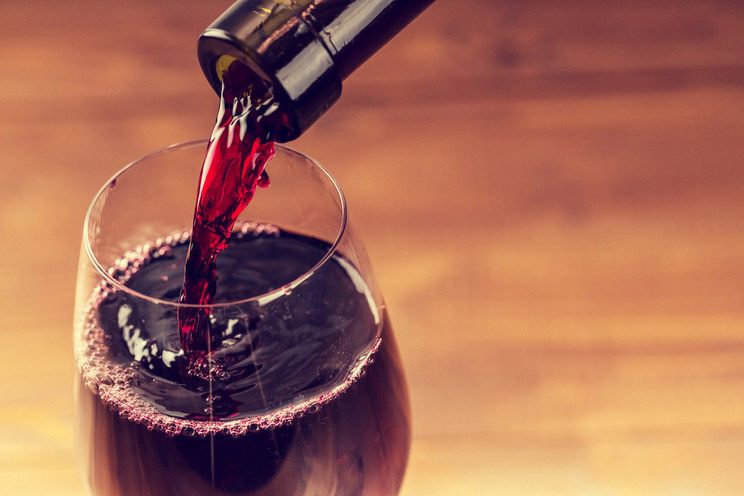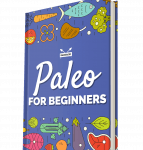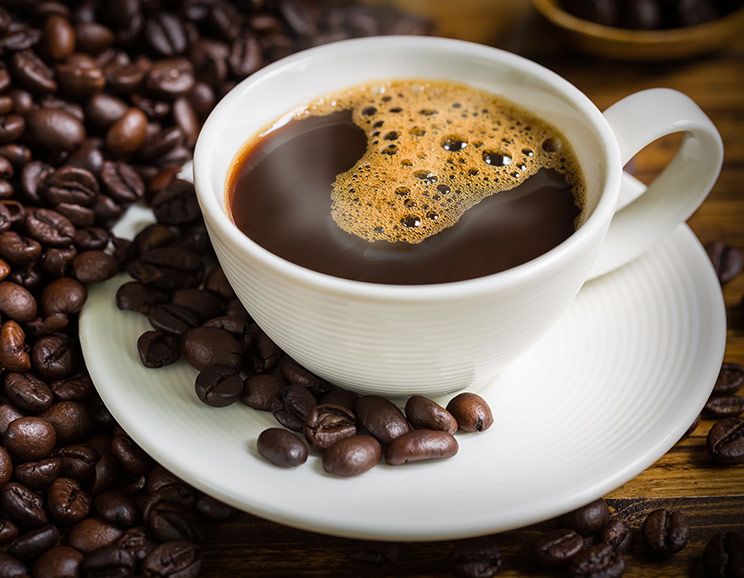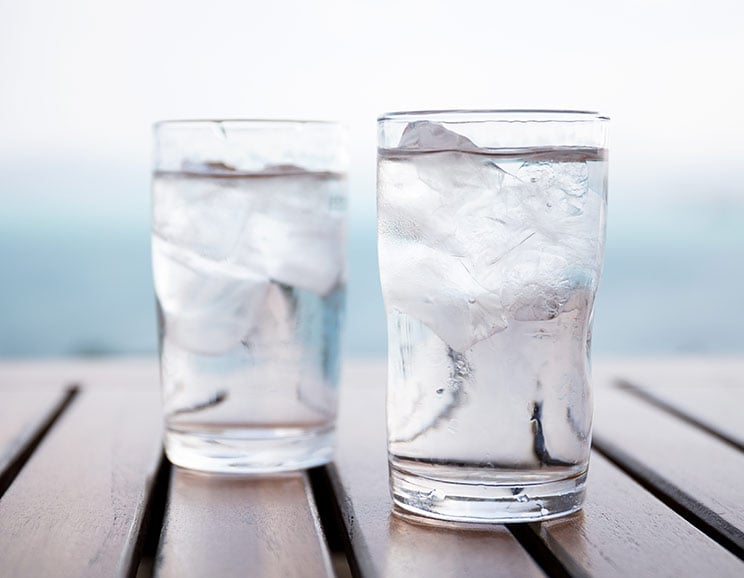Is Paleo alcohol an oxymoron? It’s not exactly Paleo to drink, but there are certain ways to make your nights out healthier.
Somehow you made it to Friday afternoon. Just a few more hours of work until you’re free. Now’s when the invitations from family and friends start pouring in: “Come out tonight!” “Want to go get a few drinks and watch my friend’s band play?” “Happy hour?”
Now that you’re eating Paleo and committed to your health, you aren’t sure how you’re supposed to handle this. Even if drinking was part of your life before, does it have a place in your new lifestyle?
This coffee cookbook is filled with healthy recipes and reveals the natural benefits of your morning brew.
Click here to get your FREE Coffee Book Today!
There’s a lot of confusion about whether alcohol is Paleo and whether you should have it. So let’s get to the bottom of this. That way you’ll have the information you need to make an informed decision.
Is It Paleo?

Before we talk specifics, you’re probably wondering whether alcohol is even Paleo. But that doesn’t necessarily mean you have to quit drinking it.
The Paleo approach is based on what our hunter-gatherer ancestors ate during the Paleolithic era. And as Dr. Loren Cordain pointed out, our ancestors just didn’t have the technology to process drinking alcohol (ethanol) during that time.
Our ancestors might have enjoyed fermented fruit juice (yeast contaminates fruits naturally from time to time), but more evidence suggests that people didn’t use technology to mass produce alcoholic beverages until the Neolithic era: 5,000 to 10,000 years ago. (1, 2)
Just because our Paleo ancestors didn’t have alcohol regularly, doesn’t mean you have to avoid it, too. Remember, Paleo is an ancestral framework to help you optimize your health and quality of life. It’s not a set of rigid rules trying to recreate exactly how things were in every little detail.
How to Minimize Alcohol’s Harmful Effects
Alcohol isn’t really going to make you healthier, but there are ways to enjoy it sensibly and minimize any negative effects.
Not all types of alcohol are created equal. Sticking to certain ones – and avoiding others – will help you enjoy a drink every now and then without jeopardizing your health.
Not sure which type of Paleo alcohol to drink? Here’s what you need to know:
Beer

There’s some disagreement in the Paleo community about whether wine or spirits are the best choice for your health. But there’s one thing everyone seems to agree on:
Beer is the worst type of alcoholic drink you can have.
Almost all beers are made from grains like barley and wheat. These are packed with gluten, which can cause a lot of health problems – even if you aren’t aware you have gluten tolerance issues. Unlike the distillation process spirits go through, beer’s direct fermentation leaves gluten residue that ends up in your drinks. (3)
There is a huge range of beers available: everything from light beers to heavy stouts and hop-loaded microbrews. But this spectrum really just goes from bad to worse. Craft beers and stouts might have more carbohydrates (and calories) than light beers, but all of them contain gluten.
Gluten-free beer is an option, and has become increasingly common as Paleo becomes more popular. But these beers still contain plenty of carbohydrates without the antioxidants found in wine or spirits, making them a mediocre choice.
Hard ciders made from fermented apples (and sometimes pears) are also on the rise for people looking for beer alternatives. Those fruits don’t contain gluten, so fermenting them doesn’t leave the harmful residue. The biggest issues to watch out for with ciders: 1) sometimes manufacturers add gluten, and 2) high sugar content.
Ciders can be a decent option if you’re looking for something Paleo-friendly to drink instead of beer. Just make sure you stick to gluten-free versions with low sugar content (check the labels if you aren’t sure). Crispin Cider, Strongbow, and ACE Cider are gluten-free and sell products low in sugar.
Bottom line: beer is definitely not Paleo. Its gluten makes it the worst type of alcohol you can drink. Gluten-free beer and cider are better, but there are potential dangers like high sugar content and carbs to watch out for. You’re better off with red wine or spirits.
Wine

Wine is produced through sugar or starch fermentation. This happens naturally with several fruits, but grapes are the most common. Grapes contain a good deal of sugar – the perfect food source for yeast. Once grapes are mashed into juice, time takes over and ferments the grape juice naturally.
This makes wine probably the oldest type of alcohol to see widespread human use. Our ancestors enjoyed it when the process happened naturally and, eventually started growing and fermenting grapes on purpose.
Wine is a better option than beer for a few key reasons. First, wine doesn’t contain gluten because it’s made from gluten-free fruits (grapes) instead of grains. Wine contain resveratrol, an antioxidant that has been shown to protect against inflammation, diabetes, and even cancer. (4) [tweet_quote]White wine is OK every now and then, but try to stick to organic, sulfite-free reds[/tweet_quote]
All in all, red wine is a better choice. The skin of the grapes are removed during white wine production. Unfortunately, this also removes tannins and resveratrol. So you get a lot less antioxidants when you drink whites instead of reds.
Dr. Loren Cordain, the creator of the Paleo diet, also pointed out sulfites as a potential concern. (5) Sulfites are preservatives wine manufacturers use to extend their products’ shelf lives. Most people don’t have an issue with them, but they might be having a negative impact – the common “hangover” sensations you feel after a few glasses – without you realizing it. Because most wines contain sulfites, the only way to know if they’re an issue for you is to try a sulfite-free wine and see if you feel a difference.
If you can, stick to organic, sulfite-free red wines. White wine is okay every now and then, but reds will give you a lot more antioxidants.
Mead

So while mead comes with slight non-Paleo risks, we think mead is a pretty acceptable overall choice. (Plus, it’s delicious).
Hard Cider

One thing to be aware of: some ciders might have added sugars or preservatives, so stick with organic brands whenever possible.
Spirits

Like beers, spirits (tequila is a notable exception because it’s made from the agave plant) are usually produced from fermented grains. But there’s an extra step: manufacturers distill spirits after fermenting them, which explains their higher alcohol content.
Why are spirits a better choice?
The distillation process actually removes most of the gluten protein residue from the grains. And some spirits like bourbon, brandy, and cognac contain helpful antioxidants. (6)
Spirits are also good because they contain very few (if any) carbs. All those carbs from wine or beer spike your blood sugar levels and stall weight loss. But you can enjoy low-calorie spirits and keep body fat from piling on. [tweet_quote]When choosing what to order at the bar, dry, clear spirits will go easier on your body than wine or beer[/tweet_quote]
Generally, dry and clear spirits are the least harmful for you. For instance, vodka or 100% agave tequila trumps dark rum (which is made from sugarcane). A lot of colored spirits also use caramel food coloring and other chemicals, so always check the label to make sure you’re getting something high-quality.
Here Are Some Of The Best Paleo-Friendly Spirits You Could Try:
Gin: manufacturers usually make gin by distilling botanicals (like juniper, coriander, cinnamon, or licorice) with grain alcohol. It can be a decent choice if you like flavored spirits, because the botanicals provide natural flavoring (unlike flavored vodkas, for instance).
Tequila: look for tequilas advertised as “100% agave”. Good brands include El Jimador, Gran Centenario, and Milagro. If that isn’t displayed on the label, you’re probably drinking a mixture of agave and added water and sugar.
Vodka: focus on vodka distilled from potatoes, or better yet, grapes. Ciroc is great because it’s distilled entirely from grapes. Brands like Chopin and Karlsson’s are fine because they’re distilled from potatoes. Grey Goose is actually distilled from wheat! Always check the labels to make sure. Be careful about some of the cheaper brands because many of them no longer distill from potatoes.
Other Important Lifestyle Factors

After choosing the type of alcohol you drink carefully, keeping a few other things in mind will help you minimize the negative health effects of drinking.
Hangovers and gaining body fat are your two biggest potential obstacles.
To avoid them, watch out for sodas, diet sodas, and other sugary mixers (like fruit juices). Stay away from tonic water, too. It’s an overlooked source of sugar. Either drink your Paleo alcohol straight, or cut drinks with water, mineral water, or club soda to avoid all the extra calories and chemicals.
Try adding a lemon or lime wedge. Citrus juices make your body a bit more sensitive to insulin, which makes it easier to avoid extra fat, and it tastes great too. (7, 8)
A lot of people struggle with not having a plan of what they’ll eat once they start drinking. Once you’ve had a few drinks, your discipline and best-laid plans start to fall apart. That greasy pizza looks more and more tempting, and you can end up binging on junk food if you aren’t careful.
Avoid this snag with a two-pronged approach: 1) eat a high protein, low-carb Paleo meal before you start drinking, and 2) have Paleo snacks on standby if you get hungry.
A moderate approach to drinking is ideal. One or two drinks is much better than five or 10. Have too much, and it’s harder to to make smart decisions. Many of us just end up drinking more.
When you do drink, make sure to have plenty of water. Switching between alcohol and water doesn’t make you sober up faster, but it hydrates your body and slows down how quickly you’re ingesting alcohol. It goes a long way toward preventing hangovers the next morning.
It’s a Personal Decision
Alcohol technically isn’t Paleo. It doesn’t offer anything nutritionally you can’t find by eating a well-balanced Paleo diet…
But that doesn’t mean you have to quit drinking.
Ultimately, it’s a personal decision. Stay away from it if you have weight to lose or are worried about overdoing it. But if you’re healthy and able to enjoy it in moderation, it’s perfectly reasonable to have a drink or two sometimes. The benefits – relaxation, bonding with friends, etc. – might make it worth it.
And you can always quit drinking altogether. Experiment with 30 days of sobriety, see how you feel, and reassess the situation.
If you do decide to drink, be smart about which type of alcohol you choose, and other lifestyle factors. You’ll enjoy the indulgence and still protect your health.
Do you drink on the Paleo diet? Why or why not? Leave a comment below and share your experience!




 7 Natural Sore Throat Remedies
7 Natural Sore Throat Remedies









Show Comments